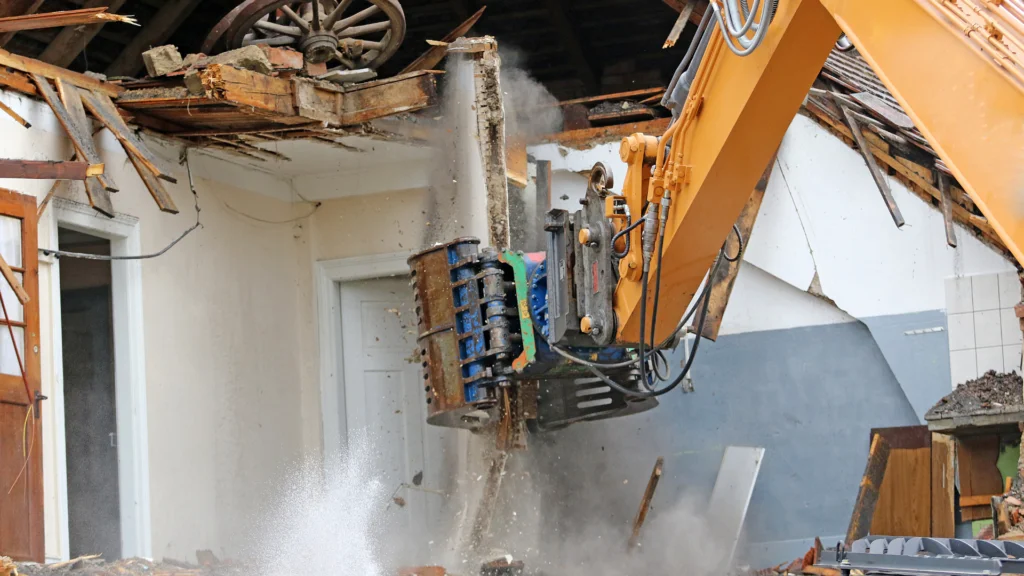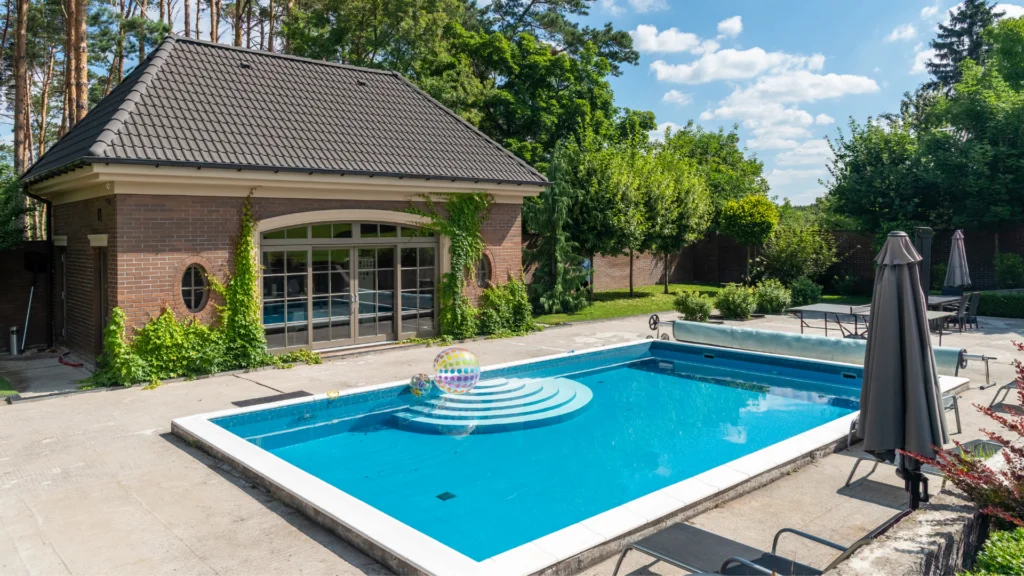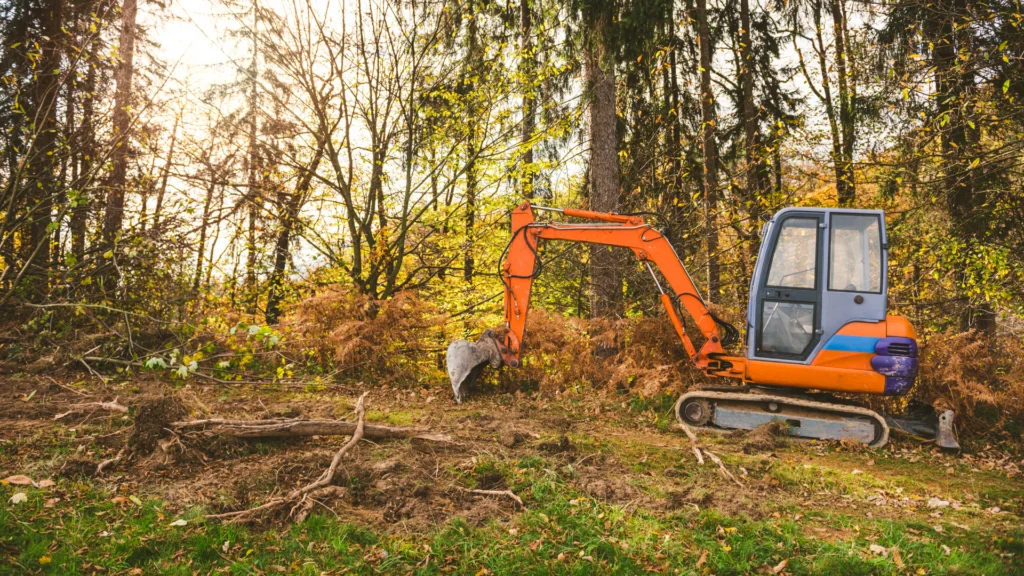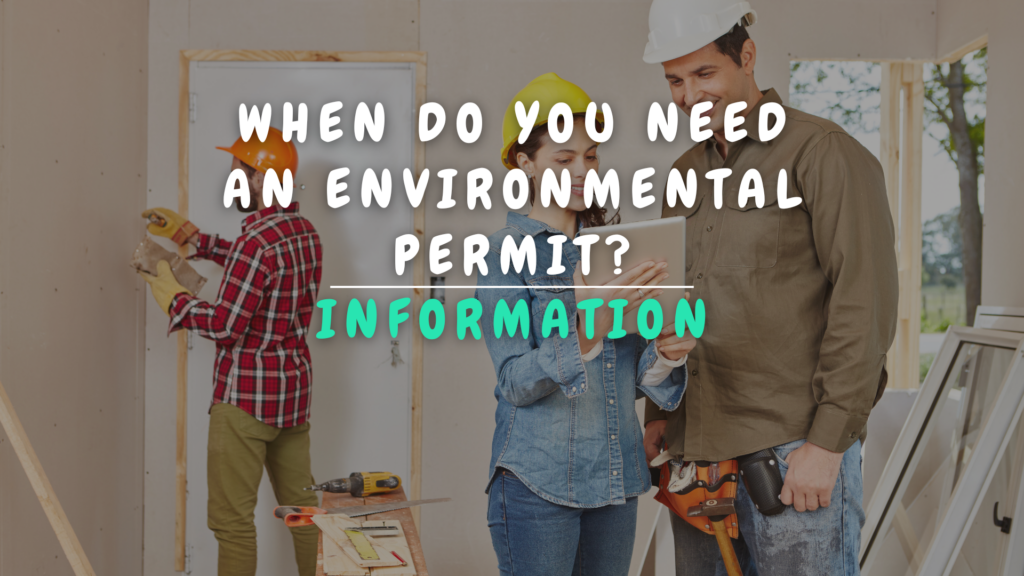You almost always need an environmental permit (formerly: building permit). For which works do and which do not? What are the exceptions? Find out here!
Contents
- What is an environmental permit?
- How much does an environmental permit and notification cost?
- What do you need an environmental permit for (+ conditions and examples)?
- Home renovation
- House construction
- Split residential units (incl. care housing) and merge
- Building function change
- Demolish house or structure
- Installing a detached outbuilding
- Installing a fence or enclosure at a home
- Installing underground installation at a residence
- Installing garden accessories
- Installing a pool, swimming or ornamental pond
- Installing solar panels, satellite dishes or air conditioners
- Placing a tent, mobile home, mobile home or storage unit near a residence
- Make relief changes at a residence
- Laying pavement
- Tree felling and deforestation
What is an environmental permit?
An environmental permit is an official permission you need to carry out various activities that affect the environment. You need this environmental permit for many works. In some situations a notification requirement applies, replacing the permit. And for some cases, neither notification nor permit is required. For an urban planning exemption, you must:
- For heritage: have approval from the Heritage Agency.
- For all other buildings: have approval from the municipality.
Note: Below are the general Flemish rules. Local regulations may be stricter. So be sure to check the exact conditions and procedures with your municipality!
How much does an environmental permit and notification cost?
The cost of an environmental permit and notification depends on where you apply for it. The price of a permit is called a filing fee.
- The cost of a report costs about 50 euros.
- The cost of the environmental permit costs between 100 and 500 euros, depending on your municipality and the procedure.
So be sure to check pricing details with the municipality in which you will be doing the work!
What do you need an environmental permit for?
Home renovation
You always need an environmental permit for urban planning operations unless you meet these conditions:
- Your home is essentially licensed or deemed licensed.
- Your project:
- does not change the function of the property.
- does not create multiple dwelling units.
- Do not expand your premises. The property must not increase in physical volume.
- complies with a special plan of construction (BPA), municipal spatial implementation plan (RUP) or subdivision permit no more than 15 years old.
- complies with the urban planning ordinances of your region, province or municipality.
- meets the conditions of the existing planning permits and environmental permits.
- complies with easements, the Civil Code and natural law.
- was approved for exemption by the municipality and no additional conditions were imposed.
Examples of works within this category
- Furnishing bedrooms in the attic
- Installing insulation, new kitchen or bathroom
- Repair damaged pavement, plaster, roof tiles
House construction
You always need an environmental permit, unless you meet the conditions below. Then you have a notification requirement.
- The area of attached outbuildings is a maximum of 40 square meters (m²) per dwelling. The areas of existing outbuildings also count in this calculation.
- The attached outbuilding is a maximum height of 4 meters measured from the ground.
- This outbuilding remains at least 3 meters from the plot boundary in the side garden and at least 2 meters from the plot boundary in the rear garden. Is the main building against the plot boundary? Then the attached outbuilding may also reach the plot boundary. Provided that you do not change the existing dividing wall and the outbuilding is not deeper than the main building.
- The Project:
- does not create multiple dwelling units.
- does not change the function of the main dwelling.
- is not zoned, not in a riparian zone and not within 5 meters along classified watercourses.
- complies with a special plan of construction (BPA), municipal spatial implementation plan (RUP) or subdivision permit no more than 15 years old.
- complies with the urban planning ordinances of your region, province or municipality.
- meets the conditions of the existing planning permits and environmental permits.
- complies with easements, the Civil Code and natural law.
- was approved for exemption by the municipality and no additional conditions were imposed.
Examples of works within this category
- Conservatory construction
- Building a garage
- Building a balcony
- Veranda construction
- Annexe building
- Building a hobby room
Split residential units (incl. care housing) and merge
Splitting your home or rejoining residential units is always subject to permit requirements except in these 2 cases:
Care Living
If you meet all the conditions of care living, you only have the notification requirement. Read all the conditions of care living in our article Care living according to legislation
Tourist rental
If you rent out your home or part of it (e.g., a room) as lodging recreation through a booking website, the function of your home changes from “living” to “lodging recreation.” A change of function of a building is always subject to a permit unless you meet these conditions:
If you rent out part of your property and:
- Your property is in a residential area and is not zoned residential.
- The main function of your property is residential. The part you rent out is smaller in area than the residential function and does not exceed 100 square meters (m²).
If you rent out the entire property:
- Your property is in a residential area and is not zoned residential.
- The change of function is temporary. So you change the function of your building temporarily, for a period of up to 4 times 30 days per year.
- Your project:
- complies with a special plan of construction (BPA), municipal spatial implementation plan (RUP) or subdivision permit no more than 15 years old.
- complies with the urban planning ordinances of your region, province or municipality.
- meets the conditions of the existing planning permits and environmental permits.
- complies with easements, the Civil Code and natural law.
- was approved for exemption by the municipality and no additional conditions were imposed.
Building function change
The change of function of a building is always subject to permit, even if you do not perform works inside or outside the dwelling. The only exception is if it is a complementary function:
- Your property is in a residential area and is not zoned residential.
- The main function of your house is residential. The part whose function you change is smaller in area than the residential function and does not exceed 100 square meters (m²). Or the change of function is temporary. So you change the function of your building temporarily, for a maximum of 4 times 30 days per year.
- The Project:
- complies with a special plan of construction (BPA), municipal spatial implementation plan (RUP) or subdivision permit no more than 15 years old.
- complies with the urban planning ordinances of your region, province or municipality.
- meets the conditions of the existing planning permits and environmental permits.
- complies with easements, the Civil Code and natural law.
- was approved for exemption by the municipality and no additional conditions were imposed.
Examples of works within this category
- You want to inhabit a shed.
- You want to live in a farm barn.
Exemptions from the licensing requirement within tourist rentals can be found here.
Demolish house or structure
Demolishing a home or structure is always subject to a permit unless you meet these conditions:
- The Project:
- Is the complete demolition of a detached building or structure. Or is the complete or partial demolition of pavements.
- complies with a special plan of construction (BPA), municipal spatial implementation plan (RUP) or subdivision permit no more than 15 years old.
- is not located in spatially sensitive areas, not in a riparian zone and not within 5 meters along classified watercourses.
- complies with the urban planning ordinances of your region, province or municipality.
- meets the conditions of the existing planning permits and environmental permits.
- complies with easements, the Civil Code and natural law.
- was approved for exemption by the municipality and no additional conditions were imposed.
- The building is:
- no architectural heritage.
- no larger than 1,000 cubic meters (nonresidential buildings) or 5,000 cubic meters (residential buildings).

Installing a detached outbuilding
Building a detached outbuilding at your home is basically always subject to a permit, unless you meet these conditions:
- The area of detached outbuildings is a maximum of 40 square meters (m²) per dwelling. The areas of existing detached outbuildings also count in this calculation. Attached outbuildings do not.
- The outbuilding is a maximum height of 3.5 meters measured from the ground.
- The outbuilding will be placed entirely within 30 meters of the main dwelling.
- This outbuilding remains at least 3 meters from the property line in the side yard and at least 1 meter from the property line in the rear yard. Is the main building against the plot boundary? Then the detached outbuilding may also reach the plot boundary. Provided that you do not change the existing dividing wall.
- The detached outbuilding:
- is not zoned, not in a riparian zone and not within 5 meters along classified watercourses.
- complies with a special plan of construction (BPA), municipal spatial implementation plan (RUP) or subdivision permit no more than 15 years old.
- complies with the urban planning ordinances of your region, province or municipality.
- meets the conditions of the existing planning permits and environmental permits.
- complies with easements, the Civil Code and natural law.
- was approved for exemption by the municipality and no additional conditions were imposed.
Examples
- Greenhouse construction
- Building a garage
- Pool house construction
- Garden house construction
Installing a fence or enclosure at a home
You always have a permit requirement to install a fence, except in these 3 cases:
1. Open connections up to 2 meters high
2. Trees, hedges and shrubs
3. Your separation meets these conditions
- Your fence or enclosure:
- is a maximum of 1 meter high in the front yard.
- is a maximum of 2 meters high in the side and back yards.
- is within 30 meters of the residence.
- is not located in spatially sensitive areas, not in a riparian zone and not within 5 meters along classified watercourses.
- complies with the urban planning ordinances of your region, province or municipality.
- meets the conditions of the existing planning permits and environmental permits.
- complies with easements, the Civil Code and natural law.
- was approved for exemption by the municipality and no additional conditions were imposed.
Installing underground installation at a residence
You always have a permit requirement to install an underground facility unless you meet these conditions:
- The underground plant:
- is within 30 meters of the residence.
- Does not lie in front of the building line or in a rear building strip.
- is not located in spatially sensitive areas, not in a riparian zone and not within 5 meters along classified watercourses.
- complies with the urban planning ordinances of your region, province or municipality.
- meets the conditions of the existing planning permits and environmental permits.
- complies with easements, the Civil Code and natural law.
- was approved for exemption by the municipality and no additional conditions were imposed.
Examples
- Drainage construction
- Installing fuel tank
- Installing rainwater well
Installing garden accessories
You always have a permit requirement to install garden accessories unless you meet these conditions:
- The Project:
- is not located in spatially sensitive areas, not in a riparian zone and not within 5 meters along classified watercourses.
- complies with the urban planning ordinances of your region, province or municipality.
- meets the conditions of the existing planning permits and environmental permits.
- complies with easements, the Civil Code and natural law.
- was approved for exemption by the municipality and no additional conditions were imposed.
Examples of works within this category
- Slide installation
- Tree house installation
- Installing a swing
- Postbox installation
Installing a pool, swimming or ornamental pond
Installing a pool, swimming or ornamental pond always requires a permit unless you meet these conditions:
- The Project:
- is a maximum of 80 square meters (sq. ft.), including all existing uncovered structures per building in the side and rear yards. Existing driveways, patios, garden paths, solar panels, current ponds and swimming pools count in the calculation.
- has no building volume.
- is not located in sensitive areas.
- is 1 meter from the property boundary.
- is less than 30 meters from the house.
- does not rise higher than 1.5 meters above ground level.
- Provides a natural means of stormwater infiltration.
- complies with the urban planning ordinances of your region, province or municipality.
- meets the conditions of the existing planning permits and environmental permits.
- complies with easements, the Civil Code and natural law.
- was approved for exemption by the municipality and no additional conditions were imposed.

Installing solar panels, satellite dishes or air conditioners
Installing solar panels, satellite dishes or air conditioners always requires a permit unless you meet these conditions:
General conditions
- Your project:
- is not located in spatially sensitive areas, not in a riparian zone and not within 5 meters along classified watercourses.
- complies with the urban planning ordinances of your region, province or municipality.
- meets the conditions of the existing planning permits and environmental permits.
- complies with easements, the Civil Code and natural law.
- was approved for exemption by the municipality and no additional conditions were imposed.
Solar Panels
- Your solar panels:
- On a flat roof: Your installation will not exceed 1 meter above the eaves.
- on a pitched roof: Your installation is on top of the actual roofing, in the same slope but against it or a few inches above it OR your installation is between your roofing and functions as roofing.
Shot antennas
- Your satellite dishes:
- with maximum diameter of 80 centimeters: located on a sloping roof behind the eaves or against the rear facade of your home in the color of your facade or in a neutral, unobtrusive color.
- with a maximum diameter of 120 centimeters: are a maximum of 150 centimeters high and are located on a flat roof or in the backyard.
Air conditioners
- Your air conditioners (as well as ventilation pipes, chimney pipe, chimneys, gutters and drain pipes) do not extend more than 3 meters above the ridge of the house.
Placing a tent, mobile home, mobile home or storage unit near a residence
Do you want to place a tent, mobile home, mobile home or storage unit near a residence? Then a permit requirement always applies unless you meet these conditions:
- The Project:
- is not occupied.
- you can’t see from the public road.
- is a maximum of 10 cubic meters in volume.
- is less than 30 meters from the house.
- complies with the urban planning ordinances of your region, province or municipality.
- meets the conditions of the existing planning permits and environmental permits.
- complies with easements, the Civil Code and natural law.
- was approved for exemption by the municipality and no additional conditions were imposed.
Note: If you occupy this structure, a permit is always required!
Make relief changes at a residence
Do you want to make a relief change at your home? If so, a permit requirement always applies unless you meet these conditions:
- The Project:
- does not change the function of the site.
- Changes less in volume than 30 cubic meters per dwelling in total and changes less than 0.5 meters in height or depth.
- is not located in spatially sensitive, erosion-prone or flood-prone areas.
- is not in a riparian zone and not within 5 meters along classified watercourses.
- Does not fully or partially dampen ditches or watercourses or interfere with the natural flow of water between plots.
- complies with the urban planning ordinances of your region, province or municipality.
- meets the conditions of the existing planning permits and environmental permits.
- complies with easements, the Civil Code and natural law.
- was approved for exemption by the municipality and no additional conditions were imposed.
Laying pavement
Do you want to build a pavement near your home? If so, a permit requirement always applies unless you meet these conditions:
- The Project:
- is a maximum of 80 square meters (sq. ft.), including all existing uncovered structures per building in the side and rear yards. Existing driveways, patios, garden paths, solar panels, current ponds and swimming pools count in the calculation.
- has no building volume.
- is not located in sensitive areas.
- is 1 meter from the property boundary.
- is less than 30 meters from the house.
- does not rise higher than 1.5 meters above ground level.
- Provides a natural means of stormwater infiltration.
- complies with the urban planning ordinances of your region, province or municipality.
- meets the conditions of the existing planning permits and environmental permits.
- complies with easements, the Civil Code and natural law.
- was approved for exemption by the municipality and no additional conditions were imposed.
Note: Overswelling a (lane) moat is always subject to permit requirements. Constructing a parking lot is always subject to permit requirements.
Examples of works within this category
- Driveway construction
- Laying pebbles
- Installing artificial turf
- Metered barbecue landscaping
Tree felling and deforestation
Tree felling
Felling tall-stemmed trees requires a permit, except if you meet the conditions below. High-stemmed trees are trees with a circumference of at least 1 meter a height of at least 1 meter.
- The tree:
- Is not part of a forest.
- is not in a residential park area.
- does stand in an agricultural, residential or industrial area.
- stands up to 15 meters from your home.
- The Project:
- complies with the urban planning ordinances of your region, province or municipality.
- meets the conditions of the existing planning permits and environmental permits.
- complies with easements, the Civil Code and natural law.
- was approved for exemption by the municipality and no additional conditions were imposed.
Deforesting trees
Deforestation is always subject to a permit. When applying for this environmental permit, you must include a forest compensation proposal.
How much do you need to compensate?
You have to multiply the area you will deforest by 1 or 3. This depends on the value of the forest. You can find the calculation for forest compensation here.
How to compensate?
- Forest compensation in kind: You carry out afforestation/planting yourself.
- Forest compensation in kind by a third party: A third party performs the afforestation/planting for you. You can find a third party through boscompenseren.be
- Financial Forest Compensation: You make a contribution to the Forest Compensation Fund. With that contribution, the Flemish Government will carry out your afforestation/planting.
Note: You may combine the ways with each other. For deforestation of more than 3 hectares of forest, financial forest compensation is not possible. You can find the exceptions for forest compensation here.

Sources: Leuven, Province of Antwerp, Flanders
Would you like to cite this article as a source? Then use:
Stiasteny, L. (2024, June 18). What do you need an environmental permit for? Apartment.com. Consulted on (date XX/XX/202X), from https://www.appartement.be/waarvoor-heb-je-een-omgevingsvergunning-nodig
Related articles:
- Buying building land, what is the progression?
- Apartment as revenue property according to legislation
- Solar panels on apartment buildings according to legislation






